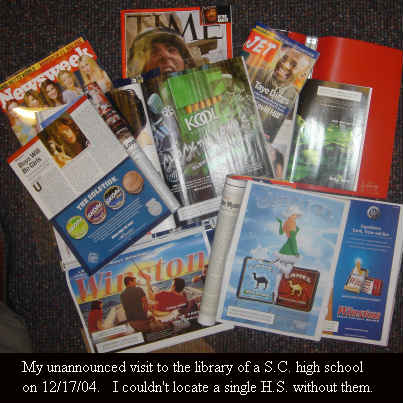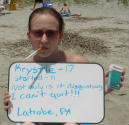
Attorneys General Consent to
School Tobacco Advertising
Will blame belong to the National Association of Attorneys General (NAAG) if America's middle and high schools remain flooded with magazine tobacco advertising this fall? On Monday, were its lead smoking prevention attorney generals (AGs), from New York and Iowa, simply politicking for governor while standing on the backs of teens and tweens being bombarded by in-school tobacco marketing, or were their efforts sincere?
On June 20, New York Attorney General Eliot Spitzer boasted "major success" in producing an agreement between magazine publishers, tobacco companies and the NAAG to use selective binding -- a sixteen-year-old technology -- to remove tobacco advertising from public school library editions of Time, Newsweek, People and Sports Illustrated.
"This is another important step," said Iowa Attorney General Tom Miller, co-chairman of the NAAGs Tobacco Committee. Both men have expressed 2006 gubernatorial ambitions.
Another important step? It's taken seven years to demand removal of ads from just four in-school magazines and scores remain. Why are we stepping so slowly, why are we stepping at all? Major success? What surgeon would declare "major success" after intentionally leaving dozens of cancer tumors beside four that were removed?
Although the nation's AGs clearly have the means and muscle to almost immediately produce an entire nation of schools free of tobacco ads, no state's AG, or the NAAG, has yet declared an intent to free them. Why? Is it that they fail to see the crime in intentionally chemically enslaving and then slowly destroying a child?
Tobacco Industry Dependent Upon Youth
 The sad fact that almost 90% of new smokers continue to be children or teens seems almost inescapable. But the promise of Section III(a) of the 1998 Master Settlement Agreement (MSA) between 46 states and all major U.S. cigarette companies could not have been clearer.
The sad fact that almost 90% of new smokers continue to be children or teens seems almost inescapable. But the promise of Section III(a) of the 1998 Master Settlement Agreement (MSA) between 46 states and all major U.S. cigarette companies could not have been clearer.
It states that, "No Participating Manufacturer may take any action, directly or indirectly, to target Youth within any Settling State in the advertising, promotion or marketing of Tobacco Products."
It was fiction when agreed to, is fiction today, and the ink of tomorrow's lie is already dry. Truth is, the tobacco industry must find replacements for the almost half a million U.S. smokers who annually smoke themselves to death.
Cradle to teen, the tobacco industry must continue to impress, blister and burn the subconscious minds of immature brains with thousands of invitations to smoke nicotine, or resign itself to steadily declining profits and growth.
To a tobacco company it must be a thing of beauty when a decade's worth of bombardment culminates in a fifteen-year-old experiencing a single "what the heck" moment that will thereafter daily extract chemically compelled payments for life.
The ongoing deception is to pretend to be fishing for young adults, knowing full well that almost all are far too mature and intelligent to bite. Victory is achieved when the spray from shotgun type pleasure, taste, friendship and adventure marketing daily produces collateral damage youth dependency counts of at least 2,000.
The latest craze is the tobacco industry's return to t.v. commercials with bold new corporate image "trust us" campaigns. The almost daily messages are guaranteed to keep youth constantly curious and thinking about smoking.
If a parent or teen listens and orders Philip Morris's "Peer Pressure & Smoking" booklet, on page 13 it will be falsely suggested that it's impossible for a teenager to get addicted until they've smoked for at least a few weeks. Talk about an invitation to experiment!
Ohhhhh, how I wish it were true. Just five cigarettes over three days and then that first mandatory feeding command arrived. A recent WhyQuit survey has taught me that dependency onset experiences like mine are far too common.
But Philip Morris's implied promises go even further. The commercials almost seem to say, "Trust us, if you get hooked just visit our website and we'll help you quit." The only problem is that Philip Morris doesn't have a quit smoking program.
But there are no adult targets inside America's middle or high schools. What possible defense could a tobacco company present for intentionally invading and pushing nicotine inside a child's learning sanctuary? What could they possibly argue? That the magazine publisher forced them to do it?
Selective binding technology has long given magazine publishers the ability to create hundreds of different advertising versions of any particular magazine issue. They compare a particular ads target group to a rapidly growing database of personal information gathered about each of us, and then deliver an ad tailored issue to the correct subscriber with almost 100% pinpoint accuracy.
Nicotine Addiction as Permanent as Alcoholism
Maybe our AGs have been so busy with illegal drug cases that they've missed a growing scientific awareness that smoking or chewing nicotine is extremely addictive, that it quickly desensitizes the brain, and that, as stated on Canadian cigarette pack warning labels, "studies have shown that tobacco can be harder to quit than heroin or cocaine."
A recent animal study published in the March 2004 edition of Molecular Pharmacology found that nicotine causes the brain to grow millions of extra acetylcholine receptors in eleven different regions.
Imagine a chemical so overpowering that two-thirds of youth smoking it become physically addicted, with one-third eventually being deprived of an average of 5,000 days of life.
 Dependency onset and loss of autonomy happen much quicker and at far lower nicotine intake levels than previously believed. A study published in the June 2005 edition of Journal of Pediatric Psychology found that 86.8% of students who smoke nicotine at least once daily are already chemically dependent using dependency standards contained in the Diagnostic and Statistical Manual for Mental Disorders, 4th Edition.
Dependency onset and loss of autonomy happen much quicker and at far lower nicotine intake levels than previously believed. A study published in the June 2005 edition of Journal of Pediatric Psychology found that 86.8% of students who smoke nicotine at least once daily are already chemically dependent using dependency standards contained in the Diagnostic and Statistical Manual for Mental Disorders, 4th Edition.
Political Grandstanding or Meaningful Protection?
How can our nation's AGs sleep at night knowing that they've intentionally allowed a plethora of tobacco ad rich magazines to remain inside America's schools, magazines such as Cosmopolitan, Ebony, Entertainment, Essence, Field & Stream, Fortune, Glamour, Jet, Money, Outdoor Life, Popular Science, Popular Mechanics, Road & Track, Sound & Vision, and Vanity Fair?
Do our nation's elected attorneys think that parents, students and educators have "stupid" written across their foreheads? Does it take being a lawyer to come to the realization that by telling a publisher whose magazine empire numbers 130 (Time Inc.) that it must pull tobacco ads from just three, that we'd be consenting, at least temporarily, to leaving the rest?
Attorney General Spitzer's office indicates that the current agreement is verbal, with no binding formal written promises, and amazingly denies granting implied consent to continue marketing tobacco via other magazines still inside schools. But if Spitzer has good reason for delaying demand that all tobacco ads be immediately removed it's a well kept secret.
Our nation's AGs struck a somewhat similar deal in November 2003 involving removal of tobacco ads from classroom editions of Newsweek, TIME and U.S. News & World Report.
But that agreement was so poorly put together and monitored that it took a handful of complaining New York students from Reality Check to wake-up the NAAG to the fact that its last victory was a bit less than claimed. A survey of 223 N.Y. middle and high schools found that 70% contained tobacco ad versions of Newsweek, TIME, Sports Illustrated and People magazine.
Once secret tobacco industry documents reveal that tobacco companies and magazine empires have long been strong marketing partners. Not only is there a leadership pipeline between industries, for more than a decade they've merged and shared customer databases, including info on youth residing within a magazine subscriber's home.
An April 25, 1994 Philip Morris document discusses its entry into selective binding. "Initially, we limited our discussions to Time Inc., since they are our primary business partners and the best equipped (with the largest database) to do the job." The 1994 memo contains the shocking yet still unfulfilled acknowledgment that "if we demonstrate that we CAN limit advertising to known smokers, in the future, we may be forced to do just that."
Never, ever, has there been a clearer case of youth targeting than catching tobacco companies pushing nicotine inside America's schools, a full decade after they knew that they didn't need to be there. How many more years will pass before our AGs declare another "major success" after taking another baby "step" and demanding that one or two more school magazines become free of tobacco ads - until the 2010 governor's race?
NAAG Ignoring MSA Enforcement Obligations
 It isn't just school magazines being neglected. Look closely during your next visit to the neighborhood convenience store. Are tobacco ads hanging above candy and chip displays? If so, do you really think they're there by chance? What would your state's AG have to say about them?
It isn't just school magazines being neglected. Look closely during your next visit to the neighborhood convenience store. Are tobacco ads hanging above candy and chip displays? If so, do you really think they're there by chance? What would your state's AG have to say about them?
Look closely at the ads themselves. Do adult smokers really smoke in order to make new friends, for flavor, pleasure or adventure, or do they do so because they must, because the anxieties hurt when they don't?
There are no taste buds inside human lungs. Almost all adult smokers are true drug addicts, and any image teaching youth otherwise is not only unfair and deceptive but likely constitutes actionable consumer fraud. What does your AG think?
What if your AG were to openly prosecute an adult for buying cigarettes for a child under 14, a few stores for knowingly selling to youth, or file a civil action to declare a convenience store with mountains of exterior tobacco signs in close proximity to a school a public nuisance? Media coverage of just one prosecution could positively alter life for thousands of youth.
With smoking having a 50% adult kill rate, how many lives could actually be saved by your AG being dedicated to altering pubic perceptions of what's right and wrong when it comes to what dependency scientists consider one of the most addictive chemicals on earth?
How serious is your AG about protecting youth from smoking a chemical that is responsible for 30 times more deaths than all illegal drugs combined?
Once addicted to using nicotine to raid, rob, and steal your own neurochemicals -- primarily a dopamine/adrenaline high -- other risks seem to melt away as additional stealing comes easier. What is your AG's understanding of nicotine being "THE" gateway drug? Ask them why underage smokers are 3 times more likely to drink alcohol, 7 times more likely to smoke marijuana, 15 times more likely to use cocaine and 41 times more likely to use hallucinogens.
If you live in Florida, Georgia, Illinois, Indiana, Kentucky, Mass., Nebraska, NC, Ohio, Oklahoma, SC, Texas or Utah, you may just be wasting your breath in asking. According to campaign disclosure records at FollowTheMoney.org, your AG owes a portion of his or her re-election to tobacco industry campaign contributions.
Imagine your state's top law enforcement officer being entirely comfortable accepting money from the industry directly responsible for marketing your state's number one killer - chemical addiction to smoking nicotine. It's a conflicts of interest nightmare.
The NAAG should be fighting for state laws insulating underage minds from all tobacco marketing - period. Nine times more addictive than alcohol (10%) and six times more addictive than powdered cocaine (15%), one or the other, we need to either deny nicotine or youth access to the neighborhood candy store, grocery store and pharmacy. Why put liquor in liquor stores and nicotine in candy stores?
Attorney Generals Miller and Spitzer are honorable and decent men. Both truly seem to care. But this is one of the easiest cases they've ever encountered. I'm sorry, gentlemen, but it's a pretty hollow victory when the industry can simply shift advertising dollars from one of the four magazines mentioned in your verbal agreement, to one that isn't.
I hope all AGs agree that they need to complete the task at hand if they expect their alleged concerns to be taken seriously. Youth smoking prevention begs "real" NAAG leadership. The tobacco industry has no business inside schools. It needs to be tossed out on its butt and permanently expelled.

